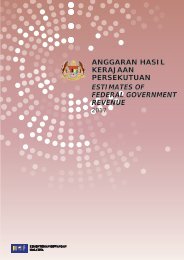WEALTH
2c0esX1
2c0esX1
Create successful ePaper yourself
Turn your PDF publications into a flip-book with our unique Google optimized e-Paper software.
MACRO<br />
Economic logic would have demanded a<br />
different investment approach. Hoarding<br />
government bonds condemns insurers and<br />
pension funds to low returns, aggravating the<br />
looming pension threat and depriving the<br />
private economy of much-needed long-term<br />
risk capital. If only governments were to use<br />
this cheap financing to boost investments, for<br />
example in infrastructure.<br />
TRANSPARENCY IS KEY<br />
Unfortunately, this is not happening. In the<br />
eurozone between 2007 and 2014, public debt<br />
increased by €3,200 billion and annual general<br />
expenditures by €730 billion, while annual<br />
gross investments decreased by €27 billion.<br />
Before the crisis, more than 7% of all<br />
expenditures were earmarked for investments;<br />
today the share is only 5.5%.<br />
The lamentable state of the eurozone<br />
economy requires a boost to real investments<br />
such as infrastructure. There is certainly<br />
no lack of opportunities: climate change,<br />
poverty and migration, digital revolution,<br />
aging societies – to name a few. The common<br />
denominator is better infrastructure that can<br />
withstand extreme weather conditions, foster<br />
growth and productivity, close the digital<br />
divide, and serve the elderly. However, most<br />
governments have underinvested in public<br />
infrastructure for many years.<br />
What is needed is a new mind-set and<br />
framework to transform the flow of capital<br />
into infrastructure. This is why radical ideas<br />
should not be dismissed easily. One proposal is<br />
a clever idea from Dag Detter and Stefan Fölster<br />
in their book The Public Wealth of Nations. It<br />
observes that while most states own assets<br />
that easily exceed their public liabilities, these<br />
assets are often poorly managed.<br />
This situation arises for the reason that<br />
governments lack a clear view of the true<br />
value of public assets. While the financial<br />
crisis forced countries to acquire a better<br />
understanding of public debt structures and<br />
contingent liabilities, they still underrate their<br />
assets, especially on the sub-national level.<br />
There is no comprehensive public balance<br />
sheet with accounting rules comparable to the<br />
private sector. But, as Detter and Fölster write,<br />
“transparency is a key to better management.”<br />
Every euro that can be earned by better<br />
management of public assets is a euro less in<br />
taxes or debt. Detter and Fölster’s solution<br />
includes an integrated inventory of public<br />
assets at all levels of government with<br />
valuation at market prices. Furthermore,<br />
to ensure effective management and a<br />
comprehensive business plan for asset<br />
development, assets should be transferred and<br />
consolidated into a single corporate entity.<br />
At the national level, this would mean, for<br />
example, the creation of a national wealth<br />
fund (NWF) that has the mandate to increase<br />
public wealth by maximizing the return on<br />
public assets. Asset management would be<br />
shielded from short-term political influence,<br />
and the time-proven tools and frameworks of<br />
the private sector and professional governance<br />
would be employed.<br />
The idea may not sound revolutionary.<br />
There are already many sovereign wealth<br />
funds around. But applying this approach to<br />
a wider range of public assets would mark<br />
a decisive turn: public assets would no longer<br />
be seen primarily as cost items – gobbling up<br />
money for maintenance – but as wealth that<br />
generates positive returns and revenues.<br />
INVESTORS AS RISK ABSORBERS<br />
What is elegant about the idea is that it<br />
avoids the fruitless ideological debate about<br />
privatization versus nationalization. The<br />
emphasis is efficient management. However,<br />
the barriers are large. Politicians are unlikely<br />
to surrender influence to independent<br />
managers, as public assets – from roads to<br />
railroads – are often intertwined with political<br />
and social objectives. Although the fund<br />
approach does not hinder these objectives per<br />
se, it would reveal associated costs. It is not<br />
difficult to see then why some policymakers<br />
might favor the opaque status quo.<br />
This would be a pity because wealth funds<br />
should boost investment in infrastructure.<br />
First, the mandate would sharpen the focus<br />
on needed infrastructure – because it is<br />
the most valuable asset yielding the highest<br />
returns. Second, a professional fund would be<br />
more open to pooling with private partners,<br />
giving the public-private partnerships (PPP)<br />
concept a new lease of life.<br />
MICHAEL HEISE<br />
Chief economist of<br />
Allianz SE and the<br />
author of Emerging<br />
from the Euro Debt<br />
Crisis: Making the Single<br />
Currency Work<br />
58 • Allianz



